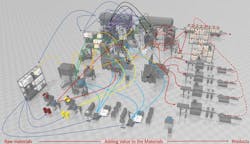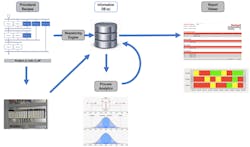One meaning of the term “forensics” is the application of scientific knowledge to problems. Forensics involves the scientific analysis and data analysis of physical evidence. In a plant environment, data and scientific analysis can be the key to discovering opportunities to improve the automation solutions that exist. Forensic tools can be utilized in all phases of the life cycle of a system, but ideally, they should be used during the design phase.
Opportunities to improve on the initial design are missed due to budget and time constraints, often euphemistically called “value engineering.” Sometimes design is difficult to understand, maintain, and improve. Occasionally, commissioning was not as detailed as it could have been, leaving untested scenarios. If any of these scenarios are true, the overall performance of the systems will not be optimal. The systems’ agility, throughput, quality, safety, personnel, or product can be impacted. Living with a subpar solution can have many hidden costs. Remedying them can lead to a huge return on investment (ROI). The key is applying scientific principles and techniques through collection, examination, and analysis of physical evidence and data.
Batch Forensics focuses on evaluating the gaps and their remediation. In some cases, the gaps are obvious and may be identified by operators complaining about the system. Sometimes, the gaps may be identified by the quality department, by the operations department, or even other groups. Occasionally, the opportunities for improvement are not obvious and may require analyzing data that’s available but not captured by the existent solution (thus you need to dig deep).
For example, by digging deep and studying the gaps, the data may indicate that some control loops need tuning or indicate that the operators in a shift are taking longer than expected to perform manual tasks. Having this type of information is paramount to determine the best remediation opportunities. Often, end users have most of the required infrastructure to capture actionable information but do not know how. Others may be capturing this information but do not have the information analyzed and presented in an easily understood format, thus making it undiscernible.
Other examples can be found in areas such as material receiving, inventory management, weighing and dispensing, material dosing, process control and strategies, finished product storage, and packaging. Automated, as well as manual activities, can be tracked electronically. Time series data and transactional procedural data provide unambiguous information and analytics that give insight into the reality of the process. Reporting this information in a correct and discernable format to the required audiences allows for understanding of how the quality, quantity, cost, and risk can be improved.
The key to improvement is applying scientific principles and techniques through collection, examination, and analysis of physical evidence and data. Work with a trusted resource of engineers that can collaborate on the initial Automation design or help identify gaps and create a remediation plan.
Timothy S. Matheny, P.E. is the president of ECS Solutions, a certified member of the Control System Integrators Association (CSIA). He is also author of a paper on model-based control, presented to the ISA Food and Pharmaceutical Industry Division in 2014. To obtain a copy of Matheny’s paper, or for more information about ECS Solutions, visit its profile on the CSIA Industrial Automation Exchange.
About the Author
Timothy S. Matheny
President, ECS Solutions Inc.

Leaders relevant to this article:


